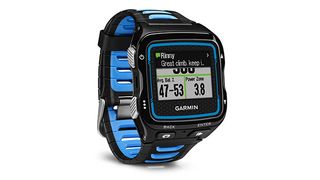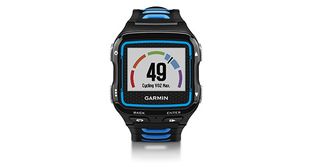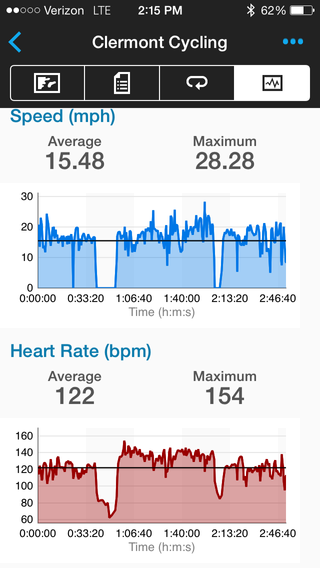Garmin Forerunner 920XT Review
For dedicated triathletes (running, biking and swimming), the Garmin Forerunner 920XT GPS watch is an excellent training tool.
Why you can trust Tom's Guide

Until I started training for triathlons, the most sophisticated watch I owned did little more than tell time. As I got more serious about the sport, I started to run longer distances for Ironman races, and began integrating heart rate into my workouts. I knew I needed an upgrade to get me to the next level.
That's why I was happy to be able to test the latest GPS watches to see how they stacked up while I swam, biked and ran. The $450 Garmin Forerunner 920XT proved to be the best: not only was it the fastest to connect to a GPS signal, it also delivered the most comprehensive data in an easy-to-use interface. Plus, this watch has a lot of enticing extras, such as Wi-Fi syncing. Here’s why the Garmin 920XT deserves to be at the top of the podium.
Design
I was delighted to turn on the 920XT and instantly feel like I knew my way around the watch. The buttons and functions are well-labeled and intuitive. While the six buttons on the 920XT — two on each side, and two below the face — definitely make it easier to navigate, aesthetically it screams “sports watch,” and is not something that you’ll want to wear when you’re not working out.

The 920XT’s large 1.1 x 0.8-inch display (205 x 148 pixels) lets you see a lot of info at once. Or, if you prefer to view just one metric (such as heart rate), it can be displayed in large numbers, making it very easy to read at a glance. Even though it’s a color screen, the majority of the data is shown in black or white, making the data visible even in sunlight. The Polar V800 also is capable of showing up to four metrics on screen at once, but with a smaller watch face, they are less visible mid-run.

At 2.2 x 1.9 x 0.5 inches, the 920XT was the largest of the watches I tested, but felt slimmer and more snug on my wrist than the rest. Weighing 2.1 ounces, the Garmin is lighter than the Suunto Ambit3 Sport (2.8 ounces) and TomTom Multi-Sport Cardio (2.2 ounces).

As someone who has a smaller wrist, I found that the 920XT’s flexible band helped make this large-faced watch fit nicely on my arm. I was initially concerned that the size of the watch might be burdensome while I was swimming, but to my surprise I barely even noticed it was there. Swimming with the thicker Suunto Ambit3 Sport (1.9 x 1.9 x 0.6 inches) was more of a distraction, and I felt more drag in the water.

The watch I tested was black with blue accents — and it looked sharp — but Garmin also sells a red-and-white version, which I’ve seen matched with triathletes' bikes and race kits. You can purchase the 920XT for $450, but Garmin also bundles the watch with a heart rate chest strap for $500.
Performance
In addition to GPS, the 920XT has a barometric altimeter, which helps ensure even more precise altitude readings. Normally, it takes a GPS watch a minute or two, or even longer, to acquire a signal — time I usually use for stretching — but the 920XT was so quick to find a signal that I was surprised when I heard it beep. While stretching is important, it was a treat to be able to head out the door and start my run almost immediately.
MORE: Best Fitness Trackers
The 920XT also picked up the heart rate from the chest strap almost instantaneously, and maintained its connection to both the strap and GPS throughout my training. By comparison, the TomTom Multisport took longer to acquire a signal, and even lost its signal once mid-run.
Running
In my previous uses of GPS watches for running, I have only used running pace, time, distance and heart rate. The 920XT does all that and does it well. I like that I can have four metrics up at once if I want: distance, time, pace and heart rate, and that I can easily switch to another screen and see my lap averages.

Everyone trains differently, which is why I liked that the 920XT’s screens are customizable for number of data fields and type of metric. While all the watches I tested allow for this sort of personalization, I found the process to be much smoother and easier to figure out on the Garmin.
Biking
The 920XT was the only one of the four GPS watches I tested that is compatible with my bike's ANT+ power meter. That means I could use the watch as a bike computer, eliminating the need for an additional piece of equipment.

I found, though, that it wasn’t ideal to look at data on my wrist while cycling. Fortunately, Garmin sells a bike mount ($40) and quick-release system ($22), which allow you to strap the watch to the bars or mount it to a quick-release unit and pop it out and put it on your wrist. While the Suunto and Polar V800 can connect to Bluetooth power meters, the TomTom Multi-Sport Cardio can’t connect to any at this point. For triathletes who want to have all their data on one device, this can be an issue.
Swimming
I have to admit, I'm not a big fan of anything high tech in the pool, but the 920XT is converting me. I could easily read the large watch face in the water, even through my foggy goggles. It was also the most comfortable watch to wear when I was swimming.

It wasn’t perfect, but the Garmin was fairly accurate in calculating my distance in the pool. In open water, the 920XT was more helpful. While the speed wasn’t perfectly accurate, I could see the places where I went faster or slower, which was helpful to me. The watch can also record more detailed swimming metrics, like average stroke rate, but I didn’t find that it was always accurate or particularly useful. By comparison, I found the Suunto to be both cumbersome and inaccurate.
Triathlon Functions
Now, this is where these watches start to get fun! You can set up the data you want to see in each of the legs of a triathlon, including transitions. After starting the watch at the beginning of a race, I could then press a button when I switched to the next sport — say, from swimming to biking — and the information shown (i.e., speed for bike vs. min/mile for run) on the watch would change automatically.
MORE: Fitness Tracker Buying Guide
At the end of the race, all of the data is in one file, which is very convenient. You can also customize sports if you do a duathlon or another type of multisport event.
Downloading and Transferring Data
Unlike most other GPS watches, the 920XT has built-in Wi-Fi, and you can program up to seven different networks into the watch. While other watches, such as the Suunto, can also sync wirelessly to your phone via Bluetooth, I loved the convenience of being able to simply walk into my house, or my training partner’s home, and have my workout data automatically transferred to the cloud. Fortunately, this didn’t seem to affect battery life. The watch also pairs with the Garmin Connect app through Bluetooth.
The Garmin Connect app is like a command center for my activity. I found it much easier to install and navigate than the companion apps for other GPS watches.

From its main screen, I could monitor my steps, sleep and exercise in one place, in addition to seeing all of my workout details — all without having to turn on my computer.

In addition to sending data to your Garmin Connect account, you can also automatically sync the 920XT to third-party apps such as Strava. That way, I could come home from a run and my coach could see all my data before I was out of the shower.
Other Features
The 920XT has some other fun features, such as a step counter and a sleep monitor. It doesn’t have full fitness tracker functions, like quality of sleep, but does count steps and sleep hours and activity. These additional tools are very helpful in my training, as sleep and extra walking (essential for recovery) are two of the things my coach asks me about on a regular basis. It’s nice to have everything streamlined into one place to find that information.
Another cool feature is that you can get texts and other smartphone notifications on the Garmin’s screen. So, if you are sneaking in a workout while you’re supposed to be at work, you won't miss anything.
Battery Life
Garmin says the 920XT will last up to 24 hours in training mode, 40 hours in UltraTrac mode (which decreases the rate of GPS syncing to once per minute) and up to four months in watch mode. After I charged it once, the 920XT wasn’t even fully drained after a week of several activities. The automatic sleep mode on the watch helps with this. To be fair, all of the watches I tested seemed to have good battery lives.
Bottom Line
Out of the four GPS watches I tested for triathletes, my hands-down favorite is the Garmin Forerunner 920XT. It has all the features I need, and even the ones I don’t — such as live tracking and smartphone notifications — are pretty darn cool. It was the most comfortable and easiest device to use, and the 920XT found both a GPS signal and my heart rate quickly. The large color display is another perk.
At $450, the 920XT is pricey. The $299 TomTom Multi-Sport Cardio or $199 Multi-Sport (which lacks a built-in heart rate monitor) are excellent options for beginners, but for serious triathletes, the Garmin Forerunner 920XT is worth the investment.
Sign up to get the BEST of Tom’s Guide direct to your inbox.
Upgrade your life with a daily dose of the biggest tech news, lifestyle hacks and our curated analysis. Be the first to know about cutting-edge gadgets and the hottest deals.
